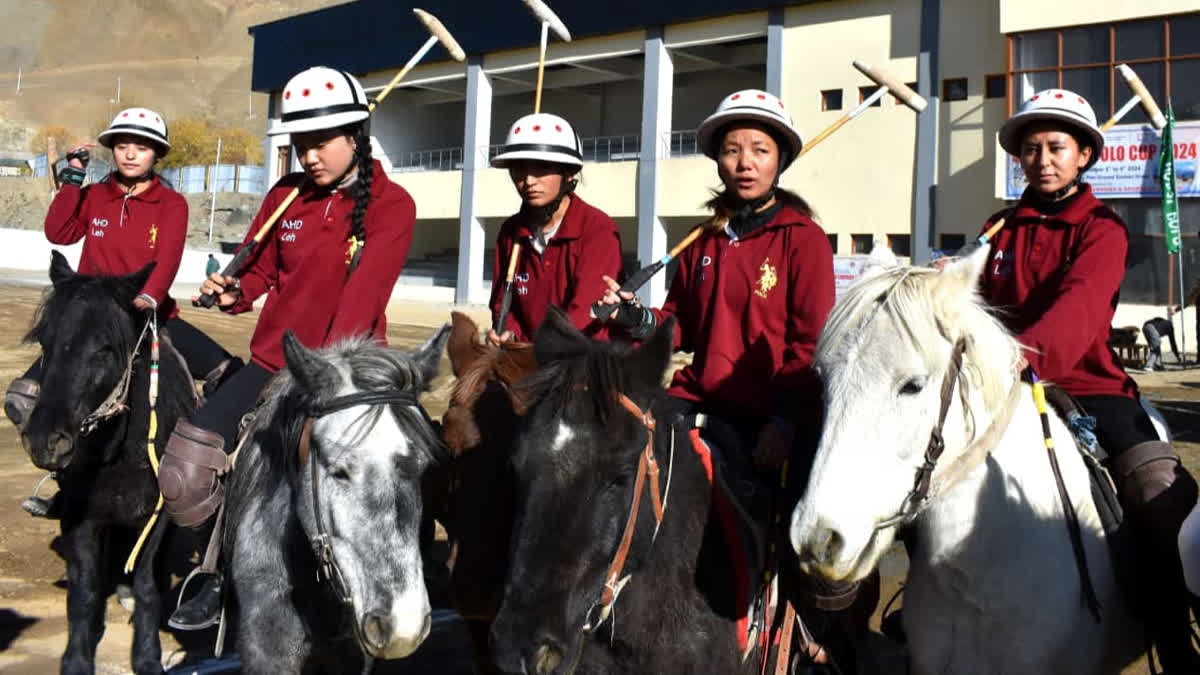Ladakh: In the high-altitude valleys of Ladakh, a centuries-old tradition is finding new life, powered by an unexpected force—women. Polo, known as the king of all sports, has historically been dominated by men in Ladakh. Today, however, women are not only embracing this ancient game but also excelling, rewriting its legacy and inspiring others. The newly inaugurated Horse Polo Stadium in Goshan, Drass, built at a cost of ₹6.84 crore, marks another step in reviving the sport. The UT Administration’s initiative to send girls from Leh and Kargil to Delhi for polo training with the President’s Body Guard has further fueled this momentum. Last year, 12 girls from Leh participated, and this year, 12 girls from Kargil are undergoing training—a testament to the region’s growing commitment to women’s polo.
Mohd Amin Polo, President, Polo Promotion Committee Drass, explains, "Polo was once played in nearly every village and corner of Ladakh. Its formal establishment dates back to the 16th century. The sport came to Ladakh in the 17th century when King Jamyang Namgyal married a Muslim princess from Skardu, now in Pakistani-administered Kashmir. As part of her dowry, the princess brought polo along with musical instruments like the daman and surna. Evidence of polo's rich history in Ladakh can still be found in the shagaran areas—designated spaces for polo matches—scattered across the region. Unfortunately, most of the shagarans (polo playing grounds) in Ladakh have disappeared over time, as both government and private constructions have taken over these spaces. Today, only two to four shagarans remain across the entire region.”
Deachen Angmo, Captain, the Students' Educational and Cultural Movement of Ladakh (SECMOL) Polo Team, shares, "I’ve been playing polo for the past two years, starting with the Chushot team and this time with Secmol. In 2013, I learned that secmol was offering horse riding lessons, which sparked my interest. Many people believe women are weak, but I wanted to prove them wrong, and this experience has greatly boosted my confidence. Despite facing discouraging remarks, I stayed focused and continued playing polo. I was also part of the training at the President's House in Delhi last year, where 10 girls from Ladakh participated. Today, I’m proud of my journey, and I actively encourage more girls to play polo. This time, we won the Fourth Lieutenant Governor Polo Cup in Drass, and I plan to form more women’s teams in Ladakh."
Mohd Amin Polo says, “Polo, a traditional game deeply rooted in Ladakhi culture, owes much of its prominence to King Jamyang Namgyal, who played a key role in promoting it historically. Looking ahead, I am hopeful that more women's teams from Ladakh will emerge, further enriching the sport’s legacy.”
“Most of the polo teams and horses in Ladakh are based in Drass. Unfortunately, the tradition has declined over time, with the most significant damage occurring after the Kargil War. Before the war, Drass was renowned for its abundant livestock, including horses, sheep, goats, and cows. Every household used to keep 5–10 horses and 50–60 goats or sheep. However, the war forced us to relocate, leaving much behind. Initially, we tried to manage, but eventually, we had to abandon our homes and livestock due to constant shelling. For three to four months, there was no one to care for the animals, resulting in heavy losses. This marked a turning point for the culture of livestock rearing in Drass, especially for horses. Keeping horses in Ladakh is challenging—it requires care even during harsh nights. Sadly, many of our finest horses were killed in the shelling, some went missing, and others fell prey to wild animals. The loss was so significant that even today, we haven’t fully recovered or compensated for it,” says Mohd Amin Polo.
“However, today, the people of Drass collectively own around 1,000 horses, with 100–120 of them dedicated to polo. We have also requested the government to provide subsidies on horses for polo players to support the upkeep and training of quality horses. Currently, there are 10 polo teams in Kargil and a total of 16 teams across Ladakh, reflecting the gradual resurgence of this traditional sport,” says Mohd Amin Polo.
He continues, “In 2012, we initiated the Lalit Suri International Polo Tournament, which was held annually for four years (2012–2015) in Drass. The tournament attracted players from countries like Mongolia, France, and others, bringing international attention to the region. This event significantly contributed to the revival of polo in Drass, rejuvenating interest in the sport.
